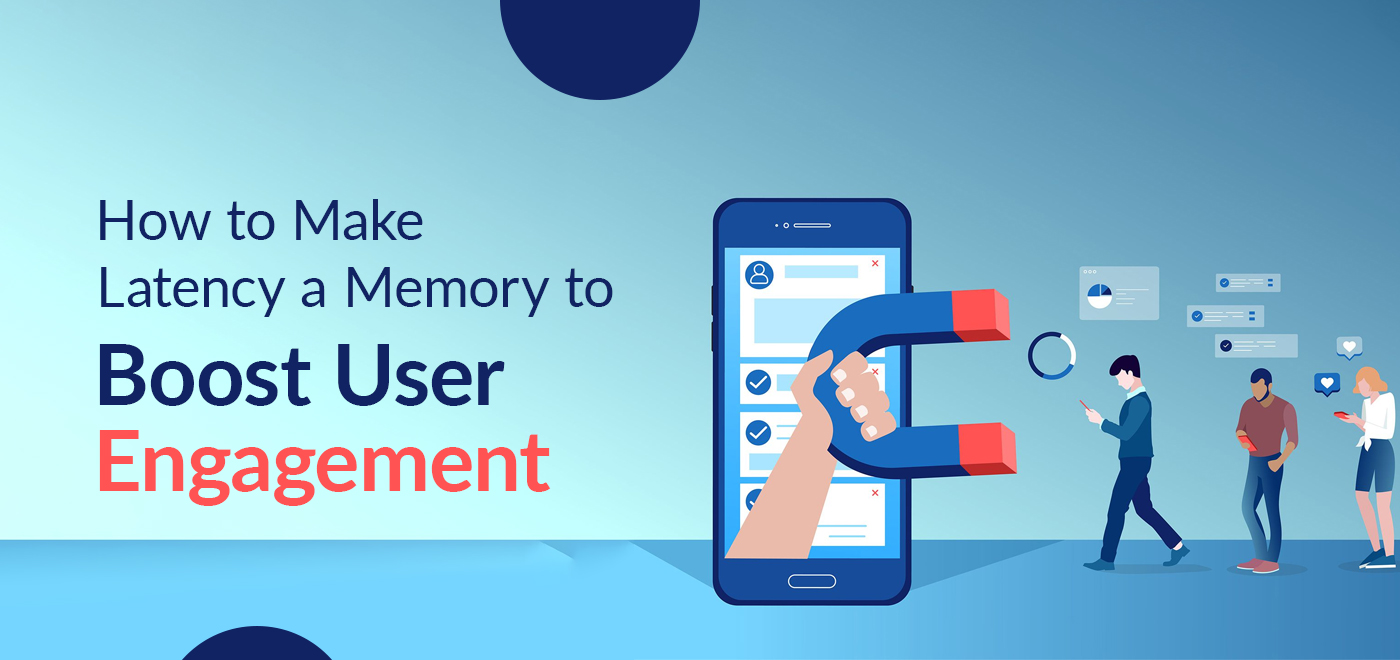For businesses everywhere there’s one issue that can fundamentally plague their software and that’s latency.
Not only are there serious costs to organizational efficiency but also this can bleed into user experience and user engagement. Obviously this is never desirable for businesses as ultimately latency can undermine workflows, accuracy, services quality, and much more.
For this reason, in this article we’ll explain the risks of Software Latency and how businesses can approach this to:
- Identify how latency is affecting business outcomes
- Strategize how to overcome software and app latency
- Understand how to re-connect and boost user engagement
Let’s get started with strategies for prioritizing latency minimization to see business results that deliver lasting value.
Key statistics to know about Software Latency and its impact on businesses
To begin with, we’ll look at the key statistics and facts about software latency. Mozilla web developers explain that, “Latency is generally considered to be the amount of time it takes from when a request is made by the user to the time it takes for the response to get back to that user.”
So, what does this time-based metric look like in the market and how does this negatively affect businesses?
Firstly, let’s look at the online UX — right now almost every user is interacting with businesses over an internet connection. Whether that’s through a mobile app or website, any lags are immediately frustrating for users. In fact, Google reports that bounce probability increases 32% when page load time goes from one second to three seconds. Furthermore, Neil Patel reports that 40% of consumers will abandon a site that takes more than three seconds to load. To demonstrate the impact of this for e-commerce businesses in particular, Patel explains that, “If an e-commerce site is making $100,000 per day, a 1 second page delay could potentially cost you $2.5 million in lost sales every year.”
What other areas does Software Latency affect?
Therefore it’s clear that latency directly feeds into poor UX. Not only does this undermine the general UX but also the UI for a lot of businesses. Presently this problem is becoming more pronounced as UX becomes more video-centric. For instance, streaming platforms need robust bandwidth to deliver their product yet one in four users will leave a page that takes more than four seconds to load.
Due to the rise in video streaming for entertainment and media, data-heavy value offerings need to perform. When they don’t, the range of negative UX/UI problems are extensive. Both glitchy streaming and buffering issues, particularly for live streaming, leads to users abandoning the platform or loudly complaining online. Neither of these outcomes are desirable nor does it actually result in better platforms where latency is overcome.
More businesses competing with one another in the streaming space — with paid media companies trying to beat social media platforms — adds more pressure, too. Now that users have more choices, businesses need to deliver products that are reliably enjoyed from start to finish. Otherwise, those users will take their dollars elsewhere. What’s more, one Amazon study found that each 100-millisecond delay in load times could damage conversion rates by 7%!
Major businesses that lost out due to Software Latency
Above all, we need to note Trung Nguyen’s assessment for IBM that businesses need to be aware of how latency issues can coalesce and cascade. Nguyen writes, “Latency in small operations isn’t a big deal, but when handling millions of operations, there are millions of latencies that add up fast.” Basically then businesses need a dynamic understanding of the range of problems that contribute to and arise from latency.
Right now, there’s more and more high-profile examples of businesses suffering in real time due to latency problems. Here are two examples of latency that’s caused real-time impact to two leading businesses.
Netflix livestream challenges
Recently, Netflix wound up pulling its reality show Love is Blind reunion livestream when the scheduled special endured sizeable delays. Consequently the streaming giant let down fans of the show while enduring the global embarrassment of large-scale tech failure. Evidently Netflix hasn’t folded but this raised questions about the reliability of their infrastructure for individual viewers and commercial investors.
In order to resolve this kind of issue, Netflix needs a comprehensive resolution on system bugs as their spokespeople say their infrastructure is up to live-streaming. Provided that all systems can handle live-streaming traffic then issues with their software could be resolved through re-engineering.
Google Cloud server issues
By comparison, Google customers in the US-East experienced server lags throughout “US peak hours” in March 2023. When this happened users reported high latency along with error messages that wound up being attributed to “cloud load balancing”. In detail, this engineering problem meant that businesses whose workloads were concentrated in the impacted servers had outages or challenges accessing their systems. On this occasion, engineers worked on resolving the issue though it made business difficult for customers operating on those servers. Simultaneously, the US Treasury had also recently flagged that financial services companies needed back-up systems should cloud providers fail.
Presently, Google Cloud is the third-largest public cloud service — after AWS and Microsoft Azure — for the B2B cloud market. Hence, these server issues could have directly disrupted any number of national and multinational companies including Paypal and Airbus. Although there’s no specific damages disclosure of this incident, if Google Cloud can’t load balance effectively then latency may continue. Seeing that risk for businesses, it’s worthwhile to evaluate if the infrastructure for network traffic is up to the task. Following this, then it may be possible to upgrade server infrastructure while maintaining workflows for Google Cloud customers.
Solutions to Latency: A case study of how A3logics Re-engineered Software helps a leading business
Transportation Software Development
Now, we’ll delve into a thorough end-to-end 101 of Software Latency and the strategy of Re-Engineering Software
Why does Software Latency happen?
Firstly, software latency can happen in many different contexts and for many different reasons. On the one hand, there’s the experiential side of latency where latency time impacts users — both internal and external stakeholders. On the other hand, there’s the technical side of latency where specific factors like old systems slow down operations. Overall, latency may happen due to factors outside businesses’ control however steps can still be taken to minimize negative impacts.
Measuring Latency in technology such as software, apps, and websites
Before we look at factors we need to make a quick point about measuring latency.
In terms of actual quantifiable units, latency is measured in milliseconds (ms). Besides the ms unit, there is the ‘ping rate’ for speed test measurements. Generally, latency in the 30-40ms range is optimal although a ping rate of 100ms or less is acceptable. There are specific network issues that can lead to latency however for this article our focus is on software.
Contributing factors to Software Latency
- Old hardware and infrastructure
- Outdated operating systems
- Insufficient servers
- Streamlining and managing caching systems
- Poor data insights and monitoring tools for resolving issues
- Location affecting data supply and servers
Presently, common Latency examples for businesses are
- Unresponsive UX/UI in e-commerce/online shopping
- Slow page download speeds
- Lagging mobile apps
- Cumbersome UX/UI customer portals
When we look at these examples, the reality is that this slow, lagging, and unpredictable UX/UI is common.
Markedly, this is measured as “latency time” wherein metrics for websites, software, and apps are observable for
- Server response time
- Network traffic demands comparing user volume and other metrics
- System performance
- Interactive UX/UI features such as ‘the fold’ of the first-page result and e-commerce shopping ‘add-to-cart’ update speeds
How does Software Latency negatively impact businesses?
Both experientially and technically, as per Alexander S. Gillis’s description for TechTarget, “latency is a delay” leading to negative outcomes. In the context of businesses and for this article, we’re focusing on Gillis’s assertion that “low latency is associated with a positive user experience”. Subsequently, let’s take a look at how this excessive time between reaction and result winds up negatively affecting businesses.
Examples of Software Latency disrupting and diminishing businesses operations
Unprofessional UX/UI offerings
When both internal and external stakeholders find it takes too long to complete activities this then reflects on the business. Perception unchecked becomes reality and the result is disengaged users.
Poor workflow and operations
This common problem can damage businesses exponentially as users, especially staff, can’t complete tasks efficiently or even possibly effectively. Consequently this raises the risk for mistakes due to users regularly breaking focus thus increasing potential for missing key steps. In time this can cost money, compromise data, and result in breaches. Simultaneously this leads to unreliable operations, mismanagement of resources, poor organizational morale, and declining productivity.
Sub-par customer experience (CX)
User frustration impacts all businesses and this is particularly true for those with a customer-facing UI. As per the previous section, sub-par CX consists of sales or service models for public and private organizations. Accordingly this might lead to lost sales and customers, dissatisfied patrons, and even public outcry such as for government bodies. Regardless of the stakeholder type, if they are a customer then CX extends beyond the immediate value proposition.
All in all then, we can see that for businesses Latency is consistent with:
- Instability in business infrastructure and declining asset value
- Disappointing or poorly received/delivered professional offerings
- Undermining business reputation and brand integrity
- Disengagement between businesses and their stakeholders (staff and customers)
- Volatile operational conditions that hinder productivity, security, profits, and organizational growth
Why does Software Latency negatively affect users?
Before we look at latency solutions, we’ll briefly review the negative user impact of slow UX/UI for the CX. Because every business needs digital systems and services — especially for a high-quality CX — understanding UX/UI latency is essential.
Key ways Software Latency results in poor UX/UI
- Inconsistencies in speed — This disrupts userflow and makes completing tasks excessively labor-intensive. Thus this risks users associating the software with shadow work and uncompensated labor.
- Haphazard UI — Failing to meet user expectations for current technology standards is largely now seen as unacceptable. This is applicable to mobile platforms in particular and as more users opt for mobile their UX expectations are evolving.
- Timing out of activities that are high security or urgent — For example, some types of payment two-factor authorization or buying high-demand products like concert tickets. When latency obstructs these activities then users lose out in multiple ways.
Reasons why businesses need to overcome Latency for better user engagement
Though there can be issues outside of the software owner’s control, prioritizing user engagement is central to designing value propositions. Since so many businesses rely on technology to facilitate and/or fulfil the user relationship software reliability is crucial.
Further to reliability is how engaged users demonstrate preference for product. In effect this means that there’s a higher likelihood of upholding objectives like customers consistently returning or retaining engaged employees. Concurrently overcoming latency helps businesses grow through better resource management, eliminating mistakes, and preservation or restoration of brand integrity.
How does the Re-engineering Software Process eliminate Latency?
At this point, the logical question to ask is: how can businesses resolve software latency?
The solution: Re-engineering Software
For businesses whose software — including apps — is showing latency, this enables them to make significant performance, operational, and technical gains. This is why the development area of software re-engineering is a great way to target latency.
Being that software maintenance and performance can be an afterthought or a task that goes unprioritized, understanding re-engineering is important.
Even if businesses aren’t currently experiencing latency with their enterprise software, it’s a proven strategy for overcoming pervasive problems. Equally software re-engineering is part of digital transformation for operational innovation and strategic salvaging of critical infrastructure.
The technical advantages of Re-engineering Software to eliminate Latency
- Create new functionality — Extracts more out of existing software through professional upgrades. Simultaneously, re-engineering scales software to add new features or improve and retain other features.
- Revitalize software stack and legacy code — Revises software and modernizes systems to meet performance needs while retaining usable code.
- Eliminate bugs — Identifies problems in code and functionality that are affecting software quality.
- Improve organizational and system security — Ensures system features are up-to-date and consistent with security needs. Likewise this fortifies security so data and entire systems are protected.
- Transform systems for new uses — Introduces user-centric options such as code conversion for provision of web and mobile products.
- Support new platforms for businesses — Updates software so existing platforms will work with new software or hardware platforms.
- Plan future maintenance — Simplifying and enhancing maintainability for long-term business gains. Additionally this minimizes potential costs and re-development from the ground up.
How does Re-engineering Software properly eliminate Latency
Once re-engineering software is complete businesses can experience systems that are more:
- Agile
- Modernized
- Integrated
- Secure
- Powerful
- High-performance
- Technically effective and efficient
- Consistent with current technical demands
Steps of the Software Re-engineering process for Latency elimination
- Consultation meeting — Preliminary meeting to evaluate business needs and existing software stack.
- Assessment and planning — Thorough analysis of software to pinpoint identifiable problems through performance and metrics, what to retain, and project re-engineering process. Afterwards, software developers develop a re-engineering plan with strategy, business goals, technical features, UX/UI, and target metrics.
- Revising existing code and upgrading languages — Re-engineering process in line with established plan that targets architecture and design. During this step some components may be retained while new features will be introduced to replace outdated code.
- UI conversion — Further re-engineering to rework and modernize UI in look, feel, and experience. Both UI and UX improvements take place throughout steps 3. and 4. for effective modification and development.
- Gradual change — Progressive implementation leads to smooth updates that minimize risks for businesses. While implementation happens, testing continues to monitor success, maintain systems, and resolve any issues.
Case study examples where Latency led to lost business
Now that we’ve covered different angles of re-engineering software and latency reduction, we’ll review case study examples of latency. With this intention, in this section we’ll look at how these companies experienced software latency-related losses to show real-world negative impacts.
1. The Royal Bank of Scotland
For the Royal Bank of Scotland (RBS), their software latency arose from outdated platforms. Neither their IBM mainframe systems nor the system language COBOL were modernized for mobile banking. Furthermore these systems pre-dated mobile banking unfortunately leading to incidents like blocking user account access and payment processing failures. During an update in 2012, these IT glitches became a system-wide crash that cost RBS around $245 million in losses.
2. Meta Metaverse
In light of the demands their ambitious Metaverse brings, Meta (Facebook’s rebrand in 2021) is struggling with telecommunications infrastructure. Presently Meta needs at least 10-20ms latency to support its immersive VR vision. Seeing that this requires extensive new Internet exchange points to be built it may be that the Metaverse stays unrealized. On the whole, this is not entirely a Meta problem. Nonetheless, their VR value proposition relies on both software and infrastructure for delivery. Sooner or later it will become clear if this network latency results in lasting business losses for Meta.
3. Google Stadia
When it comes to Google Stadia, this is a case study of an under-performing platform that didn’t work out. In fact, the platform was neither seamless nor could it sustain data-heavy gaming that somewhat failed to successfully launch. Because of latency-related lag times, the UX/UI was so poor that Google discontinued the platform in 2023. Prior to officially closing Stadia, Google announced the wind-down in September 2022, less than three years after launch. While livestream gaming services were considered a high-value market until recently, Google’s reality was increasing operational costs undermining UX. In order to sustain the platform’s performance, Stadia would have become more expensive for users meaning there are disengagement risks. Even so, one reviewer called Stadia “Unplayable at times, magical in others…” suggesting the entire platform might have suffered latency.
How do businesses use their Re-engineered Software to cultivate user engagement?
So how should businesses work to rebuild user engagement after investing in software re-engineering? After all, the first phase is identifying latency problems followed by a second phase of re-engineering software, and then re-engaging users.
Strategies for rebuilding user engagement after Re-engineering Software and eliminating Latency
- Explain new system features — In order to reinforce how systems are designed to offer a better business product that delivers more value for users.
- Promote mobile and web offerings — This encourages users to engage on new channels and according to their preferences.
- Highlight enhanced UX/UI — Coupled with channel options, there are other benefits like faster, more efficient userflow that fulfil various areas of products/services. Moreover, this is an opportunity to highlight improved customer service UI and user-oriented systems, too.
- Communicate security features — Straightaway this shows users that the business is serious about their data and minimizing stakeholder vulnerability.
Undoubtedly every business will need to have individualized strategies for engaging users that integrate their unique value proposition
In this case, businesses could also take a promotional approach that relaunches their systems to users. Significantly they could integrate this with bringing new products or services to market so users tie value to latency reduction. Either way the objective for businesses is to maximize the investment on re-engineering through software improvements and user engagement.
What extra benefits are there when businesses eliminate Latency through Re-engineering Software?
Finally, let’s look at the other business benefits of re-engineering software and eliminating latency. Beyond user engagement, as networks get faster thanks to 5G there are many reasons for businesses to re-engineer software.
Six bonus benefits of Re-engineering Software to reduce Latency
1. Cost effectiveness
For some businesses, upkeep costs for outdated software might actually exceed the actual re-engineering costs. Contrarily for businesses trying to save money, old systems can also keep the business behind. For example, missed sales due to clunky UI or losing customers because digital options aren’t available.
2. Modernize offerings
Businesses stay at the cutting-edge of the market when their systems reflect this. On the whole this shapes UX/UI while bringing in technology that’s more sophisticated. Similarly new telecommunications infrastructure perform best with new technology so fast, modern systems have less latency by default.
3. Better system compatibility
Just as modernization is a benefit of re-engineering, similarly this creates better system compatibility. For instance, this means businesses increase their options for integrating other software and tools. Following on from this they can boost productivity through streamlining systems and strategically designing tech-oriented solutions.
4. Improve data management and storage
All 21st century businesses handle vast swathes of data. This is where re-engineering relieves stress while improving data systems as developers will evaluate data processes during their process. Hence businesses see their data well-organized, stored, and managed so there is better internal and external UX.
5. Eliminate downtime
The increased innovation enables businesses to operate more effectively and productively. When software works more efficiently through latency elimination there are more opportunities for faster output and profitable outcomes. This leads to a competitive edge both with customers and in the wider market.
6. Adhere to new compliance and technology laws
Industry standards and regulations are constantly evolving, more so in the post-pandemic period. Both the inclusion of legal responsibilities and the framework for fulfilling obligations makes compliance easier without compromising accuracy. For that reason this bolsters businesses’ reputation through consistency as upstanding upholders of compliance.
Conclusion
Despite the fact loyalty can’t be guaranteed, it’s possible to better design value propositions that establish user expectations. Meanwhile meeting user expectations consistently through high quality software with minimal latency contributes to stakeholders having a measurably beneficial UX.
In conclusion, businesses should be prepared that there are risks to re-engineering software. Rather than approaching this in a cavalier way, businesses can begin with a thorough development consultation. Software development and consultation company A3logics offer an initial consultation with no charge to help businesses understand costs and re-engineering. Without a doubt, no business should miss the opportunity to leverage existing software, reduce latency, and improve stakeholder UX/UI.




